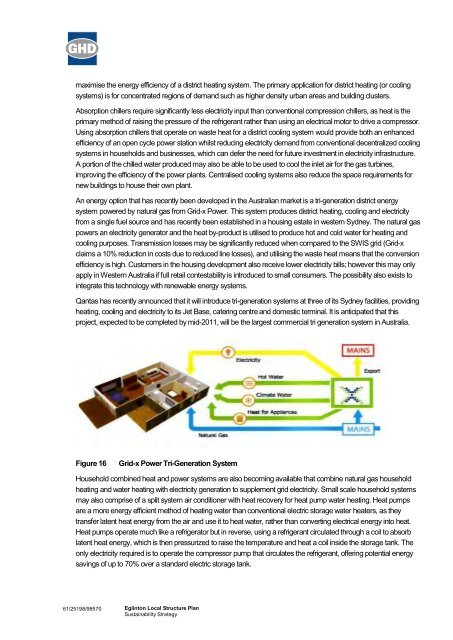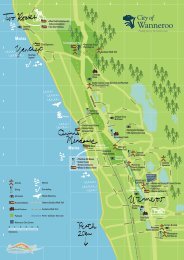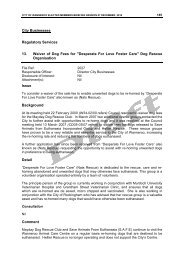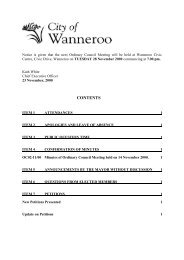EGlINTON - City of Wanneroo
EGlINTON - City of Wanneroo
EGlINTON - City of Wanneroo
You also want an ePaper? Increase the reach of your titles
YUMPU automatically turns print PDFs into web optimized ePapers that Google loves.
maximise the energy efficiency <strong>of</strong> a district heating system. The primary application for district heating (or cooling<br />
systems) is for concentrated regions <strong>of</strong> demand such as higher density urban areas and building clusters.<br />
Absorption chillers require significantly less electricity input than conventional compression chillers, as heat is the<br />
primary method <strong>of</strong> raising the pressure <strong>of</strong> the refrigerant rather than using an electrical motor to drive a compressor.<br />
Using absorption chillers that operate on waste heat for a district cooling system would provide both an enhanced<br />
efficiency <strong>of</strong> an open cycle power station whilst reducing electricity demand from conventional decentralized cooling<br />
systems in households and businesses, which can defer the need for future investment in electricity infrastructure.<br />
A portion <strong>of</strong> the chilled water produced may also be able to be used to cool the inlet air for the gas turbines,<br />
improving the efficiency <strong>of</strong> the power plants. Centralised cooling systems also reduce the space requirements for<br />
new buildings to house their own plant.<br />
An energy option that has recently been developed in the Australian market is a tri-generation district energy<br />
system powered by natural gas from Grid-x Power. This system produces district heating, cooling and electricity<br />
from a single fuel source and has recently been established in a housing estate in western Sydney. The natural gas<br />
powers an electricity generator and the heat by-product is utilised to produce hot and cold water for heating and<br />
cooling purposes. Transmission losses may be significantly reduced when compared to the SWIS grid (Grid-x<br />
claims a 10% reduction in costs due to reduced line losses), and utilising the waste heat means that the conversion<br />
efficiency is high. Customers in the housing development also receive lower electricity bills; however this may only<br />
apply in Western Australia if full retail contestability is introduced to small consumers. The possibility also exists to<br />
integrate this technology with renewable energy systems.<br />
Qantas has recently announced that it will introduce tri-generation systems at three <strong>of</strong> its Sydney facilities, providing<br />
heating, cooling and electricity to its Jet Base, catering centre and domestic terminal. It is anticipated that this<br />
project, expected to be completed by mid-2011, will be the largest commercial tri generation system in Australia.<br />
Figure 16 Grid-x Power Tri-Generation System<br />
Household combined heat and power systems are also becoming available that combine natural gas household<br />
heating and water heating with electricity generation to supplement grid electricity. Small scale household systems<br />
may also comprise <strong>of</strong> a split system air conditioner with heat recovery for heat pump water heating. Heat pumps<br />
are a more energy efficient method <strong>of</strong> heating water than conventional electric storage water heaters, as they<br />
transfer latent heat energy from the air and use it to heat water, rather than converting electrical energy into heat.<br />
Heat pumps operate much like a refrigerator but in reverse, using a refrigerant circulated through a coil to absorb<br />
latent heat energy, which is then pressurized to raise the temperature and heat a coil inside the storage tank. The<br />
only electricity required is to operate the compressor pump that circulates the refrigerant, <strong>of</strong>fering potential energy<br />
savings <strong>of</strong> up to 70% over a standard electric storage tank.<br />
61/25198/98570<br />
Eglinton Local Structure Plan<br />
Sustainability Strategy












